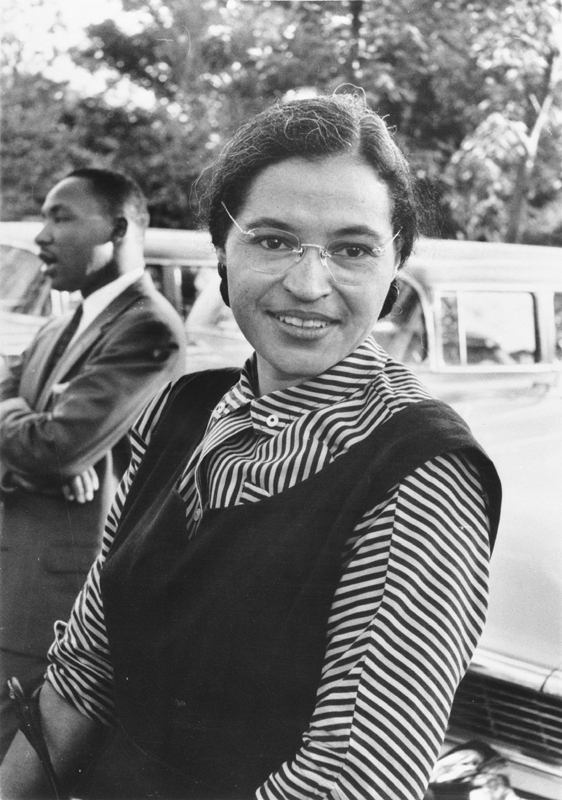Winner of the Fall 2016 StMU History Media Award for
Best Article in the Category of “People”
When one hears the name Rosa Parks, one is taken back in time to 1955, when a brave woman decided not to give up her seat. Rosa Parks was a woman who believed that the color of a person’s skin should not dictate the way a person is treated. Rosa Parks was a civil rights activist.

James McCauley, a skilled carpenter and stonemason, and Leona McCauley, a school teacher, were married on April 12, 1912, in Tuskegee, Alabama. Two months before their first anniversary, on February 4, 1913, in Tuskegee, Alabama they welcomed a daughter into their lives and named her Rosa Louise McCauley. On August 20, 1925 the McCauleys welcomed their son, Sylvester McCauley, into their family.1 The McCauley family decided to move to Abbeville, Alabama where they lived with James’s parents, sharing a bedroom with a large extended family. Rosa’s mother grew tired of the living arrangements and without her husband James around to support the family, she made the decision to leave. In 1917, when Rosa was only 4 years old, Leona took her two young children and moved back to Pine Level, Alabama where she and the children stayed with her parents. Rosa saw her father a year later when she was five and then again when she was an adult and married.2
Rosa received most of her education from her mother and grandfather as a little girl. In 1924, when Rosa was eleven years old, her mother enrolled her in the Montgomery Industrial School for Girls. The school was for African American girls seeking education; they were taught by mostly white teachers. The school focused on the domestic sciences of cooking, sewing, and housekeeping. The white people of the town accused the teachers of teaching racial equality and referred to them as Yankee black lovers. The school was later burned down by the Ku Klux Klan as they grew more powerful.3 After the Montgomery Industrial School for Girls closed in 1928, fifteen year old Rosa attended Booker T. Washington High School for her ninth grade year. She wanted to be a teacher just like her mother, so for her tenth grade year Rosa attended Alabama State Teachers College for Negros. Sadly, she had to drop out of school and return to Pine Level, Alabama to care for her grandmother who had grown ill. When her grandmother died in 1929, Rosa was only 16 years old. She moved back to Montgomery and found her first job making men’s blue denim work shirts at a textile factory. Soon after beginning her job in the factory, Rosa was forced to leave in order to care for her mother who had also grown ill.4 Rosa spent her teenage years cleaning houses and taking in sewing jobs. In 1931, Rosa met Raymond Parks, who worked as a barber and was a member of the National Association for the Advancement of Colored People (NAACP).5 The two fell in love and in December 1932, Rosa and Raymond were married. Raymond encouraged his new bride to go back to school so as to finish her education. This meant so much to her, and so Rosa completed her studies and received her high school diploma in 1934.6

By 1943 all buses in the South had long been segregated and had followed an extensive set of rules set forth by the bus drivers. Montgomery, Alabama was no exception to the segregation. All the buses had thirty-six seats; the first ten were reserved for whites only, ten seats in the back of the bus were for African Americans, and as for the sixteen seats in-between, these were for the bus drivers to decide. African Americans were frequently forced to give up their seats for whites and the bus drivers imposed their own segregation rules through the use of guns they carried with them.7
In November of 1943 Rosa boarded a bus in Montgomery, Alabama. African Americans were typically required to enter the bus from the doors located near the back of the bus, but since the bus was extremely crowded, Rosa was forced to enter from the front doors of the bus. The bus driver demanded she get off the bus and enter through the back door and Rosa refused, standing her ground and explaining to the bus driver that since she was already on the bus there was no need for her to get off because the back of the bus was already at capacity and she would not be able to enter from the back. The bus driver began tugging at Rosa’s coat to push her off the bus and so she decided to not create more of a scene and exited the bus.8
On December 1, 1955, Rosa headed to work at the Montgomery Fair Department Store on the Cleveland Avenue bus to Court Square. It was a normal day for Rosa, working her regular shift, busy as usual.9 Once work was over, Rosa was tired; her body ached, her feet hurt and were swollen from standing all day. Rosa walked to Court Square to wait for her bus and as soon as the first bus came, she saw that it was packed and decided to wait for the next one. Once the second bus arrived Rosa entered the bus, paid, and sat in the racially neutral middle section behind the movable sign which read “colored.”10 At the third stop, a group of whites entered the bus and since the last front seats were taken, one was left standing. The bus driver turned around and looked at Rosa. Rosa was shocked to see that it was the same bus driver she had had a problem with twelve years earlier. The driver, James F. Blake, began to shout at the passengers, “Move ya’ll, I want those two seats,” meaning he wanted Rosa to give up her seat. Rosa did not get up and Blake went straight to Rosa demanding she give her seat up. When Rosa still would not comply he warned her that he would have her arrested, to which she simply replied, “You may do that.”11
Once police arrived, Rosa was arrested, handcuffed and taken to the police station. At the station, Rosa was finger printed, photographed and placed in a cell. While in jail Rosa was treated badly. She requested a drink of water and a police officer yelled out to her “for whites only.” She even requested to make one phone call and was ignored. After requesting several times to make her phone call, she was finally given approval and she phoned her husband. Edgar Daniel Nixon, an African-American civil rights leader, paid a one-hundred dollar bond to bail Rosa out of jail. Rosa worked with Nixon as a branch secretary. In speaking with Nixon about the incident, Rosa decided to file suit and make a civil rights case regarding Montgomery’s bus segregation.12 On the day of trial, December 5, 1955, African Americans in Montgomery boycotted the buses and Rosa was found guilty of breaking segregation laws.13 The boycott proved to be a large protest, and it led to the formation of the Montgomery Improvement Association (MIA).14 On November 13, 1956, the Supreme Court ruled that bus segregation was unconstitutional and the boycott ended on December 20, 1956.15 Rosa became known as the mother of the Civil Rights Movement.16

Rosa Parks traveled and supported civil rights events and causes and even wrote an autobiography, “Rosa Parks: My Story.” In 1999, for all her accomplishments and beliefs as a strong African American, Rosa was awarded the Congressional Gold Medal, which is the highest honor in the United States presented to a civilian.17 On October 24, 2005, at the age of 92, Rosa Parks passed away. She became the first woman in the nation’s history to lie in state at the U.S. Capitol.18
Rosa Parks left a major impact on America and made history. She stood up for what was right for herself and for the people, not because of the color of their skin but because she believed that everyone should be treated equally. She boarded a bus at the end of a long work day, tired and wanting to go home, not realizing that she would forever change segregation in America. Rosa Parks was a very noble woman and she left behind a legacy that will never be forgotten.
- Salem Press Biographical Encyclopedia, January 2016, s.v. “Rosa Parks,” by Tammy K. Baggett. ↵
- Douglas Brinkley, Rosa Parks (Penguin Group Penguin Putnam Inc., 2000), 20-21. ↵
- Brinkley, Rosa Parks, 28, 29, 36. ↵
- Brinkley, Rosa Parks, 36. ↵
- Brinkley, Rosa Parks, 38. ↵
- Salem Press Biographical Encyclopedia, January 2016, s.v. “Rosa Parks,” by Tammy K. Baggett. ↵
- Brinkley, Rosa Parks, 57. ↵
- Brinkley, Rosa Parks, 58-59. ↵
- Salem Press Biographical Encyclopedia, January 2016, s.v. “Rosa Parks,” by Tammy K. Baggett. ↵
- Brinkley, Rosa Parks, 105. ↵
- Brinkley, Rosa Parks, 106-107. ↵
- Brinkley, Rosa Parks, 73, 108, 109, 111, 113, 114. ↵
- Brinkley, Rosa Parks, 152. ↵
- Brinkley, Rosa Parks, 134. ↵
- Brinkley, Rosa Parks, 152, 170. ↵
- Rosa Parks: “The First Lady of Civil Rights,” Bill of Rights Institute, March 2, 2012, http://billofrightsinstitute.org/rosaparks/. (accessed November 7, 2016). ↵
- Salem Press Biographical Encyclopedia, January 2016, s.v. “Rosa Parks,” by Tammy K. Baggett. ↵
- Salem Press Biographical Encyclopedia, January 2016, s.v. “Rosa Parks,” by Tammy K. Baggett. ↵




79 comments
Carolina Wieman
Rosa Parks was an activist who fought for African American rights during the peak of racial segregation. She was an educated woman taught by her mother and father due to her not being able to attend a proper education due to the color of her skin. In 1955 she decided to take a bus ride that would change her life. In 1943 she road a bus in Montgomery, Alabama she was usually forced to enter through the backside of the bus due to African Americans only being able to use the tail end; because it was so crowded she had to enter the front which was reserved for white people. A man came up to her to tell her to get up and move to the back, she was tired of the abuse calmy denied his request. She was abruptly taken to jail and treated inhumanly throughout her time. She later received justice when segregation laws were deemed unfair and wrong and become known as the mother of the civil rights movement. She lit a major spark that grew into equality for all, her choice will never be undermined nor forgotten.
Daniel Gimena
Excellent article about one of the most important and influential women in US history.
Although there has been much written about Rosa Parks, even a film, it is never too much to read her history again. This woman teaches us how important it is in life to take decisions and defend that position at all cost. Rosa Parks had everything to lose by taking her decision of not getting up in that bus. She could have decided to leave the bus, with the consequences of not doing it behind, and continue her hard life, not only economically, but as a black woman in the US of 1950s. Instead she decided to stick to what she thought was right. With her action, she started one of the most important movements that started the equal rights for black and white people in the USA.
Definitely a story worth telling and keep remembering.
Lauren Castaneda
Rosa Parks was such a powerful and influential woman during the Civil Rights Activism movement. This article provided a great insight into her life and what lead her to that moment. Growing up we always learned about the Civil Rights Movements in class but never to detailed extent. I was not aware that she had been awarded the Congressional Gold Medal, which was the highest honor in the United States presented to a civilian. Rosa Parks made an impact on society that would last forever and set the example for other African Americans during this time period to not back down for what is right no matter the consequences.
Madeliine Bloom
Since grade school, black history has always been intriguing to me. I have always been fascinated learning about the adversity others have had to face. As a civil rights activist, she had a lot to overcome. One example of her many instances would be the infamous bus seat refusal. You illustrated this incident very well with a great amount of detail. She truly is how I want to be in my future, strong, independent, and believes in what she wants.
Eric Hernandez
This article was very inspiring to read. Rosa Parks actions has played a big role in to how our society has changed for the better since those troubling times. It’s also inspiring how she was able to stick up for herself and others even though she was against almost all odds by not only being African American, but also being a woman which was also a bit of trouble during those times.
Alexandria Wicker
When I was younger I was so interested by the story of Rosa Parks, and this article confirmed why. To be a black woman in her time was very hard. These woman had no rights. But Rosa Parks did not let that stop her. She spoke out for what she believed in and she continued to, even when faced with difficulties. Rosa Parks is one of the strongest woman that I have ever read about. Her story is one that deserves to be praised by everyone.
Aleea Costilla
This was an insightful article of the life of Rosa Parks, as a person who helped create a revolution for change. There is a lot of context of the infamous refusal to move from her seat on the bus story such as the prior instance with the bus driver twelve years earlier. Her courage continues to inspire generations for being able to do what many others were unlikely to. I enjoyed reading this story as it brought a better understanding of Rosa Parks and her legacy.
Caroline Bush
Great article! I enjoyed the information about Rosa Parks early life as well as her struggles during her Civil Rights activism. Its so sad that even in prison Rosa Parks was denied not only water but also her right to one phone call. Parks was a amazing activist that paved the way for many African Americans in the future to have a better life. I enjoyed reading this article details about this amazing woman and how she changed the future for many people with a simple action.
Alexis Lopez
Aurora Torres wrote an incredible article on Rosa Parks. There was a lot of background knowledge about her and also we learn more about who Rosa Parks was. I really liked to read about Rosa Parks parents and her childhood life. It was interesting to read that Rosa was already making noise with the drivers of the bus. The fact that the bus driver was tugging on Rosa to get off the bus and go to the back even though there was no room already. I didn’t now that Rosa Parks was awarded the Congressional Gold Medal. I really enjoyed this reading.
Lesley Martinez
When I hear the name, Rosa Parks I am reminded of her courageous act in 1955. However, I was unaware of her childhood. It’s eye-opening to read that Rosa Parks had so many challenges thrown at her and had to clean houses and take in sewing jobs, yet she was able to continue her education and receive her high school diploma. I am glad that Rosa Parks was able to make a difference and become the mother of the Civil Rights Movement. She will always be remembered for her valiant charisma. Wonderful article!